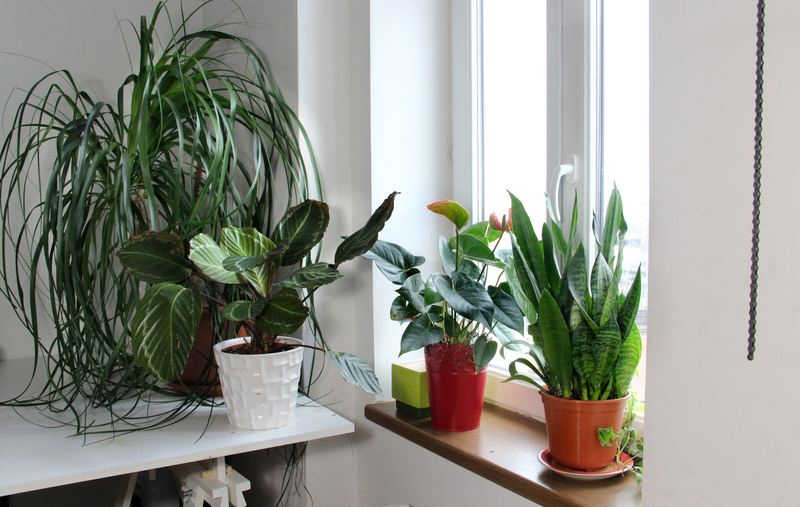Diverse Styles for Contemporary Hedge Trimming
Posted on 07/09/2025
Diverse Styles for Contemporary Hedge Trimming
In the modern era of garden aesthetics, hedge trimming has evolved from mere maintenance into an art form. Traditional styles are giving way to innovative techniques and bold shapes, transforming hedges into stunning, functional features. Whether you cherish a formal landscape or prefer a naturalistic approach, there is a hedge trimming style that matches your vision. In this comprehensive article, we explore a wide range of contemporary hedge trimming styles, tips for achieving the perfect shape, and essential considerations for long-lasting beauty.

Understanding Contemporary Hedge Trimming
Contemporary hedge trimming refers to modern-day practices that blend function, aesthetics, and innovation. Today, homeowners and landscapers experiment with diverse techniques beyond the classic straight-edged hedge. The result? Gardens with personality, structure, and timeless charm.
- Geometric Prowess: Clean lines, cubed shapes, and symmetry
- Organic Flow: Soft, naturalistic curves and relaxed forms
- Topiary Artistry: Creative designs, animals, or objects carved from foliage
- Textured Varieties: Layered heights and interplanted foliage for dynamic displays
- Functional Dividers: Hedges shaped for privacy, windbreaks, or pathways
Let's examine these diverse hedge trimming styles through a contemporary lens and discover how to transform your landscape into a living masterpiece.
1. Geometric and Linear Hedge Trimming Styles
The geometric approach is a hallmark of modern hedge trimming. These shapes--boxes, spheres, rectangles--lend an elegant and timeless quality. Geometric styles provide clear structure, emphasize architectural features, and work well for both large and small gardens.
- Box Hedges: Flat tops with crisp vertical sides, often used in formal gardens, pathways, or as property lines.
- Rectangular Pruning: Similar to box hedges, but in longer, lower profiles to define edges or create green 'walls.'
- Globes and Spheres: Curvilinear forms that soften hardscapes and offer a focal point.
To achieve these styles, precision tools (electric trimmers, sharp shears) are essential. Regular trimming encourages bushier growth and sharp lines.
2. Organic and Naturalistic Hedge Trimming
For those who favor a softer, less formal look, organic hedge trimming is on trend. These styles mimic natural plant growth, complementing contemporary outdoor environments where biodiversity and ecological harmony are priorities.
- Undulating Forms: Hedges trimmed with gentle, flowing curves resemble waves or rolling hills.
- Layered Plantings: Mixing hedge varieties at different heights for depth and interest.
- Selective Pruning: Removing only the unruly branches, thereby preserving natural shapes and blooms.
The trick to success is understanding plant habits and resisting the urge to 'tidy' excessively. Organic styles are perfect for wildlife gardens or relaxed, cottage-inspired settings.
3. Innovative Topiary Designs
Few styles rival topiary's wow factor. This ancient practice has been revitalized with contemporary topiary hedge trimming--from whimsical animals to geometric wonders.
- Modern Topiary: Abstract shapes like cones, spirals, or pyramids created with sharp tools and wire frames.
- Thematic Sculptures: Animals, objects, or logos, hand-carved for playful or branded landscapes.
- Multi-tiered Topiary: Tiers and levels, each trimmed with precision, elevate classic topiary into modern art.
Topiary requires patience and planning, but the visual rewards are profound. Using evergreens like boxwood or yew ensures that forms remain defined year-round.
4. Textural and Mixed Hedge Styles
Mixing hedge species and textures is an emerging trend in modern hedge design. Gone are the days of single-species monotony!
- Variegated Foliage: Combining green, gold, and variegated leaves for vibrant visual displays.
- Flowering Hedges: Blending flowering shrubs like hydrangea or spirea within evergreen panels.
- Layered Textures: Low ground-cover hedges interspersed with taller, bold-leaf plants.
Textural plantings bring year-round interest and serve pollinators, while varied heights enhance privacy and depth.
5. Functional Hedge Trimming Styles
Today's gardens demand more than just beauty; contemporary hedge trimming fulfills practical roles too. Well-trimmed hedges are excellent for defining outdoor "rooms," guiding foot traffic, and providing windbreaks.
- Privacy Screens: Tall, dense hedges to shield patios or houses.
- Noise Barriers: Broadleaf evergreen hedges that dampen road or neighbor noise.
- Pathway Edging: Low clipped forms that direct movement and frame walkways.
Strategic planting and shaping maximize these benefits without sacrificing aesthetics.
Choosing the Perfect Hedge Trimming Style
Selecting a hedge trimming style depends on your garden's purpose, personal style, plant selection, and maintenance capacity. Here are a few considerations to guide your choice:
- Garden Size: Geometric or topiary shapes suit larger spaces; organic forms blend well in small, intimate gardens.
- Climate and Plants: Choose styles compatible with your hedge species and regional weather patterns.
- Maintenance Level: Formal, structured hedges need consistent trimming; informal and mixed styles can be more forgiving.
- Purpose: Consider whether your hedge's function is privacy, decoration, wildlife support, or boundary definition.
Coordinate your design with other landscape features--hardscapes, flower beds, or water elements--to create a seamless, inviting environment.
Trim Techniques for Contemporary Styles
Modern hedge trimming techniques combine traditional know-how with cutting-edge tools and practices. Here's how to get professional-looking results:
- Right Tools: Use sharp manual shears for precision, electric or battery-powered trimmers for speed, and long-handled loppers for thick branches.
- Guides and Frames: For geometric or topiary styles, create templates or use wires to guide your cuts.
- Layered Trimming: For mixed or textural hedges, prune one species at a time, respecting each plant's growth rate.
- Seasonal Awareness: Most hedges prefer trimming in late spring or early summer--avoid deep winter or drought conditions for best health.
- Health Checks: Remove dead or diseased branches regularly, thin out dense areas to improve air flow, and renew old wood where needed.
Popular Plant Choices for Contemporary Hedge Styles
Achieving innovative hedge shapes and designs begins with the right plant choices. Some hedge varieties are better for sharp lines, while others thrive in wilder, natural styles. Here are top plant picks for modern gardens:
- For Formal Hedges: Boxwood (Buxus), Privet (Ligustrum), Yew (Taxus), Holly (Ilex)
- For Naturalistic Styles: Hornbeam (Carpinus), Beech (Fagus), Hawthorn (Crataegus), Viburnum
- For Topiary: Boxwood, Holly, Myrtle (Myrtus), Privet
- For Flowering/Textural Hedges: Photinia, Escallonia, Hydrangea, Spiraea, Berberis
- For Privacy Screens: Laurel (Prunus laurocerasus), Thuja, Leyland Cypress, Pittosporum
Always check the growth habits and ultimate size of a species before planting. The best contemporary hedge is one that matches both your vision and your maintenance expectations.
Eco-Friendly and Sustainable Practices
Sustainability is a key component of modern hedge maintenance. Here's how to keep your garden green in more ways than one:
- Compost Trimmings: Mulch clippings to enrich the soil and reduce landfill waste.
- Reduce Chemicals: Opt for organic pest and disease controls rather than harsh chemicals.
- Support Biodiversity: Allow some flowering or non-trimmed patches for pollinators and birds.
- Use Manual Tools: Hand-shearing uses less energy and makes less noise, preserving garden tranquility.
An eco-conscious approach ensures that your contemporary hedge trimming not only beautifies your landscape but also supports local ecosystems.
Maintenance Tips for Long-Lasting Beauty
Regardless of style, proper care is crucial for healthy, eye-catching hedges. Incorporate these expert tips to ensure your hedge looks great year after year:
- Consistency: Trim regularly--small, frequent cuts are better than occasional, harsh pruning.
- Hydration: Water deeply during dry periods, focusing on the root zone.
- Nutrition: Apply organic fertilizers in spring for robust growth.
- Monitor Pests: Inspect for insect or fungal damage and respond promptly.
- Shape Correction: Step back and assess symmetry as you work; make minor corrections as needed.

The Future of Hedge Trimming: Creative and Connected
As technology and design sensibilities evolve, so do hedge trimming styles. The future brings innovations such as robotic trimmers, smart irrigation systems, and augmented reality garden planning tools. But at its core, hedge maintenance remains a creative craft: a balance of precision, vision, and respect for nature.
Key Takeaways
- Contemporary hedge trimming styles range from formal geometrics to wild, organic forms.
- Choose the right plant for your climate, purpose, and maintenance commitment.
- Maintain health and structure with timely, mindful pruning techniques.
- Incorporate ecological practices to support sustainability and local wildlife.
- Let your personality and landscape needs guide your choice of style--hedges are as diverse as the people who shape them!
Conclusion: Unleash Creativity with Contemporary Hedge Trimming
Modern hedge trimming is more than a chore--it's your invitation to sculpt living green art. From minimalist lines to vibrant, textural displays, the options for diverse modern hedge styles are endless. Explore new techniques, experiment with plant combinations, and don't fear creative expression. With regular care and an eye for design, your hedges will become the signature of your unique outdoor sanctuary.
Ready to transform your garden with a contemporary hedge design? Dive into these diverse styles for modern hedge trimming, and watch your landscape flourish!



